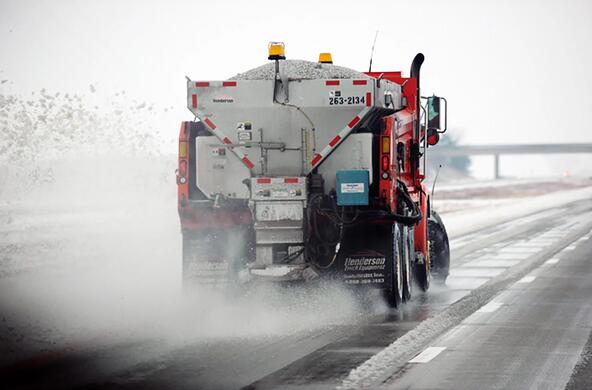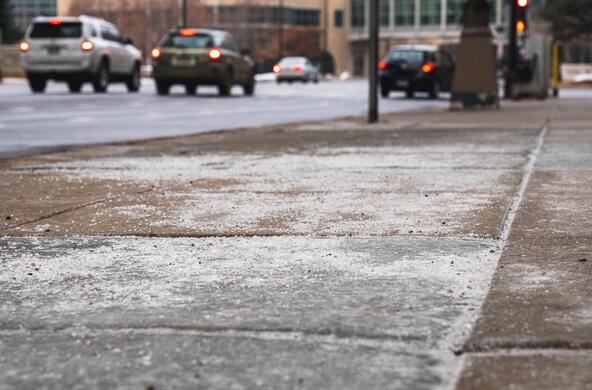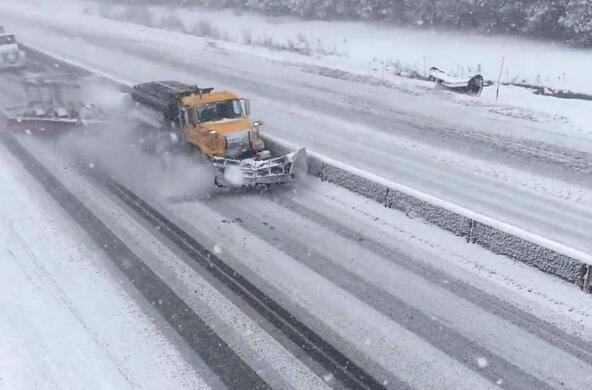A student contribution to the REU blog.
In a world where water seems so abundant, consistent access to drinkable freshwater is surprisingly scarce – so much so that the World Economic Forum ranks inconsistent access to freshwater to be among the top-five risks facing people across the globe (Global Risks Report, 2020). From drought to pollution, concerns over freshwater impact many communities.
A source of freshwater contamination that is often forgotten is road salt – a popular deicer that keeps winter roads safe, but accumulates in ecosystems over decades, where it has harmful effects. Since the early 1970s, scientists have been studying the effects of road salt on human health, the environment, and other organisms to try to understand the full impact of this winter necessity.
It was found that in one suburban area outside Boston, groundwater contamination due to road salt caused salt concentrations in the drinking water to exceed levels recommended for people on salt-restricted diets by the American Heart Association (Huling and Hollocher, 1972).

Another study found that heavy road salting around Irondequoit Bay in Rochester, New York, prevented the bay from completing vertical mixing – a seasonal process that affects the spread of oxygen throughout the water column (Bubeck et al., 1971). A more recent study found that increased salt concentrations in bodies of freshwater can cause sex reversal in some aquatic species, such as wood frogs (Lambert et al., 2017).
In order to protect people and the environment, it is important to completely understand how road salt penetrates and accumulates in groundwater, and the full extent of its impacts.
My work this summer focused on the impacts of road salt on groundwater in private wells that people use for drinking water. Part of my research involved organizing and analyzing private well reports from Dutchess County, New York, an area that experiences heavy road salting each year. These reports are from the townships of East Fishkill, Fishkill, and Wappinger and were collected from 2007 to present. The reports were taken each time a house was sold, and shared as public records on the Dutchess County municipalities website. From these reports, I mapped chloride concentration hotspots throughout the townships studied.
The second part of my study was a time series analysis of 10 private wells close to my home in Patrick County, Virginia. Originally these samples were going to be taken from residential properties in Dutchess County, New York, but due to the pandemic, travel wasn't an option.
For the 10 wells that I sampled weekly for seven weeks, I let the water run from either an outdoor spigot or the kitchen faucet for five minutes. This ensured that my sample came straight from the groundwater, and not water that had been sitting in the pipes. Treated water that had gone through a softening system, or that had sat in pipes for a long period of time, could be contaminated with additive ions, which would not be representative of the ground water.
Once I collected my sample of around 500mL of water, I then tested the conductivity with a conductivity probe. Conductivity is a measure of the ionic content and is the ability to conduct electricity. Examples of ions include chloride, iron, magnesium, and calcium. Many of these are naturally found in the soil. Road salt primarily impacts chloride concentrations, which are related to sodium concentrations. From this conductivity reading, I was able to tell whether the ionic activity of the groundwater changed from week to week. Because of a direct relationship between chloride and conductivity, I was able to make inferences about how the chloride concentration changed in well water throughout the summer.
Why is this important? A previous study found that in Dutchess County, NY – a region characterized by deciduous forest, with a lot of leafy green trees like Patrick County, VA – the average chloride concentration in streams increases during the summer (Kelly et al., 2019). This is because during the summer, the trees require a lot of water. There is not enough water from rainfall to supply both the trees and streams. Groundwater makes up the difference and it too declines as summer progresses. As groundwater in the water table declines, this may decrease the dilution of ions in the water, making the mineral and ion concentrations, such as chloride, higher. In the winter, the trees are dormant and don’t have leaves, and thus require no water. As a result, the wintertime water table isn’t usually depleted, ions are more diluted, and average chloride concentrations are lower.
There has not been much research into whether or not deeper groundwater used for wells behaves similarly to groundwater pockets located closer to the surface. If seasonal fluctuations of salt concentration occur in deeper stores of groundwater, such as those used for private wells, this could be dangerous for individuals on salt restricted diets, who could unknowingly consume water that may be detrimental to their health. Understanding these trends could help improve salt management strategies, and in the long run could prevent potential health risks.
To complement my conductivity readings, I sent my samples to Cary Institute for chloride analysis so that I will know the exact chloride concentration of each sample, and will be able to see exactly how they changed throughout the summer.
It has been an amazing experience working for Cary Institute of Ecosystem Studies this summer. The Institute has a family-like feel as all of the staff are encouraging and invested in our learning and success. My mentors have been truly wonderful in assisting me with my research project. When it was first announced that the program would be conducted virtually from our homes, and we would not be going to New York, I was relieved and skeptical at the same time. Relieved that I would be able to stay with my family during this trying time, but skeptical as to what the research would be like.

I am proud to say that even though I am over 600 miles away from the Institute, I feel like I have created a network of friendships with both the faculty and other REU students that will last me throughout my career in science. Each morning of the program, I woke up, grabbed a cup of coffee, and embraced the opportunity to be a part of a program committed to scientific discovery and rooted in community outreach. I could not have asked for a more fulfilling way to spend my summer.
Citations
Bubeck, R. C., et al. “Runoff of Deicing Salt: Effect on Irondequoit Bay, Rochester, New York.” Science, vol. 172, no. 3988, 1971, pp. 1128–1132., doi:10.1126/science.172.3988.1128.
Huling, E. E., and T. C. Hollocher. “Groundwater Contamination by Road Salt: Steady-State Concentrations in East Central Massachusetts.” Science, vol. 176, no. 4032, 1972, pp. 288–290., doi:10.1126/science.176.4032.288.
Kelly, Victoria R., et al. “Seasonal and Long-Term Dynamics in Stream Water Sodium Chloride Concentrations and the Effectiveness of Road Salt Best Management Practices.” Water, Air, & Soil Pollution, vol. 230, no. 1, 2019, doi:10.1007/s11270-018-4060-2.
Lambert, Max R., et al. “Interactive Effects of Road Salt and Leaf Litter on Wood Frog Sex Ratios and Sexual Size Dimorphism.” Canadian Journal of Fisheries and Aquatic Sciences, vol. 74, no. 2, 2017, pp. 141–146., doi:10.1139/cjfas-2016-0324.
World Economic Forum. (2020). The Global Risks Report 2020. Retrieved from
https://www.weforum.org/reports/the-global-risks-report-2020.
Abigail Williams, a student at Salem College, participated in Cary Institute's 2020 Research Experiences for Undergraduates (REU) program.
This summer, Abigail worked with Cary Environmental Monitoring Program Manager Vicky Kelly and Cary Undergraduate Program Leader and Research Specialist Kevin Burgio to study impacts of road salt on groundwater used for drinking water in Dutchess County, New York and Patrick County, Virginia








